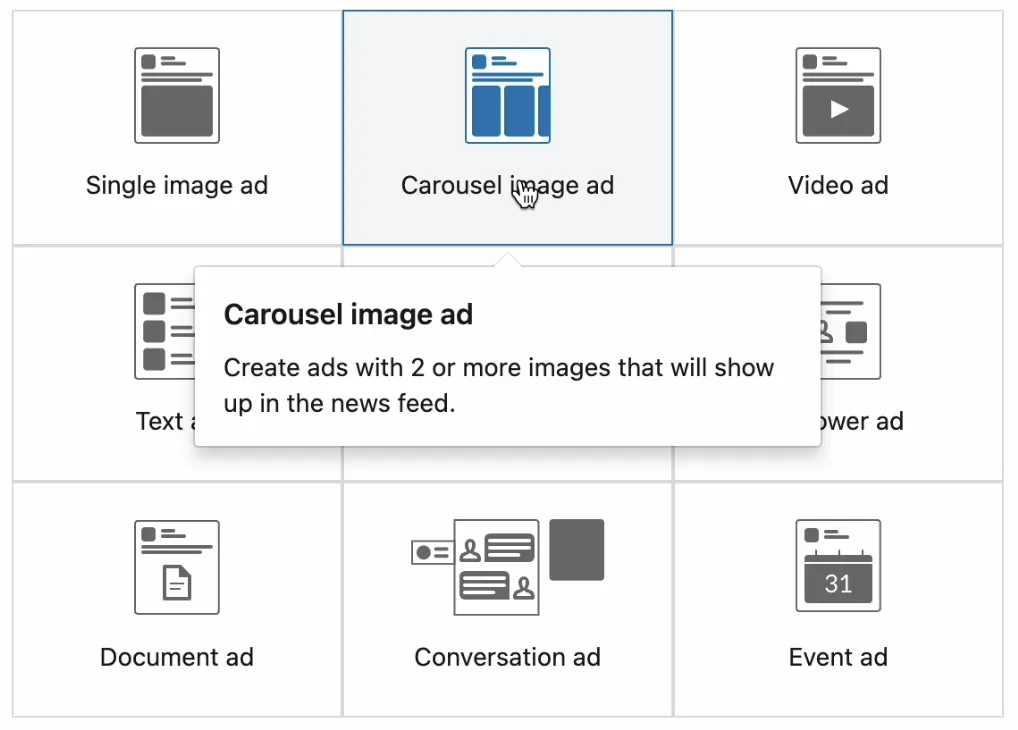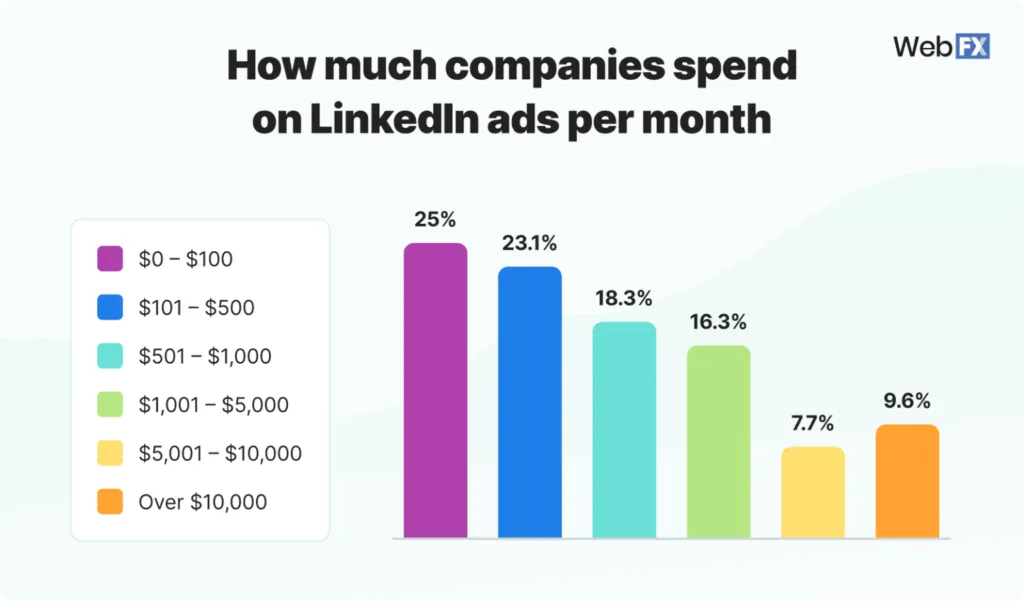LinkedIn Ads Excellence: Essential Tips and Best Practices

LinkedIn with its 810 million professionals, 61 million senior-level influencers and 40 million decision-makers has no rival in the digital advertising platform. The LinkedIn advertising space is thus a favorite of 65% of B2B companies wanting to reach customers because of its digital ad targeting possibilities. In the dynamic digital world, adopting LinkedIn ads best practices is not a choice, but a requirement for businesses interested in reaching a responsive professional audience and enhancing conversion, awareness, and conversion tracking accuracy.
To succeed in LinkedIn advertising, the crucial aspect is knowing its market position and using either objective-based advertising. It means linking ad campaigns to specific business objectives, such as to increase website conversions or to reinforce the brand. Together with recommendations on marketing performance, LinkedIn ads help enterprises navigate LinkedIn paid marketing by providing a set of targeting and bidding suggestions to run a successful LinkedIn campaign. Being the biggest online community for professionals, LinkedIn brings not only advertising but networking, brand credibility and high engagement rates, thus mastering LinkedIn ads best practices is crucial, from well-chosen CTA to A/B testing.
Introduction to LinkedIn Ads
To start your adventure with LinkedIn Ads, knowing the initial steps and the best practices in setting your campaigns right is crucial. Here’s a step-by-step guide to getting started:Here’s a step-by-step guide to getting started:
Step 1: Creating Your LinkedIn Page and Ads Account
Prior to starting an ad, you should have LinkedIn company profile. From this account, you can create a stand-alone LinkedIn Ads account. Such a dual structure will enable you to control your advertisements in a proper manner without interfering with your personal LinkedIn activities.
Step 2: Selection of Your Campaign Objective
LinkedIn utilizes objective-based advertising, allowing you to tailor your campaigns around three key business goals: Awareness, Consideration, and Conversion. Choosing the correct objective means that your campaign starts with your strategic business results.
Step 3: Focusing on the Addressee
Define your target audience. LinkedIn’s advanced targeting enables to you target the professionals with high chances of ad response. This step is very important for getting the best performance from your campaign.
Step 4: Picking the Ad Format
Select among 11 available ad formats of LinkedIn, such as Sponsored Content, Sponsored Messaging, and Dynamic Ads. Every format has a definite goal and is suitable for the particular stage of the customer journey, so choosing the right format is really important for the effectivity of the campaign.
Step 5: Costing and Time Planning
Set your advertising budget and plan your campaigns. With LinkedIn, you can flexibly allocate your budget according to different times and audience segments, which will result in getting the best value for your money.
Step 6: Your Ad Creation and Launching
Base your ad content on a strong call to action that correlates with your selected ad format and campaign goal. Once your ad has been created, enter your payment details and begin your campaign.
Step 7: Measuring Success
Use LinkedIn analytics tools or incorporate an all-in-one platform like Hootsuite to monitor your ad performance. This is crucial for evaluation of the success of your campaign and making required changes.
By doing these steps, you are able to guarantee that your LinkedIn Ads have been well-prepared to help you reach your business goals efficiently. Every stage of the process is a building block that makes a strong campaign, making use of LinkedIn’s precise targeting and strategic potential.
LinkedIn Ad Types
One of the main advantages of the LinkedIn is its diverse ad formats for differ marketing objectives and stages of the customer journey. Clearly understanding these choices is vital to ensuring that your LinkedIn advertising strategy is the most effective.
Ad Formats and their strategic applications
- Sponsored Content. These are sponsored content ads that are found right in the LinkedIn feed, perfect for promoting content to a broader audience and driving website visits.
- Sponsored Messaging. Enables direct approaching of selected LinkedIn contacts, which has potential of conversion rates.
- Dynamic Ads. Modify these adverts to several different types of campaigns, for instance increasing your following on LinkedIn or advertising an open position.
- Text Ads. Placed in the desktop interface of LinkedIn, these are created for pay-per-click (PPC) or cost-per-mille (CPM) bidding which is perfect in obtaining targeted traffic.

Objectives and Recommended Formats
- Awareness. Strive to push the brand to the forefront and initiate conversations about the brand among the target audience. Successful formats encompass Single Image Ads, Carousel Ads, and Follower Ads.
- Consideration. Concentrate on website visits and interaction. Video Ads and Conversation Ads are the recommended formats that merge in-feed and inbox approaches.
- Conversion. Advert lead generation and conversions with formats like Lead Gen Forms and Job Ads, customized to capture user attention and activation.
Ad Creativity and Engagement Best Practices
- Creativity. Articulate your audience with short, hard-hitting content that directly talks to them by using commands as “Discover more” or “Join us today” to stir action.
- Call-to-Action (CTA). Utilizing explicit, charismatic CTAs like “Register” leads to considerable growth in click-through rates. Limit the ad copy to 100 words maximum in order to retain focus and effectivity.
- Testing. Always iterate in the test of varying ad formats and creative strategies until what suits the target audience and the objectives of the campaign are found.
Select the appropriate add type and develop the approach according to your campaign aims, and you will improve the result of LinkedIn advertising substantially.
Creating a Target Audience
For an efficient creation of a LinkedIn target audience, one should make use of the advanced targeting features that the platform offers, which enables accurate audience segmentation based on intricate professional parameters. Here’s a breakdown of how to utilize these options to maximize your LinkedIn advertising success:Here’s a breakdown of how to utilize these options to maximize your LinkedIn advertising success:
Granular Targeting of Personalized Ads
LinkedIn provides very detailed targeting options for personalized ads. It is possible to target users based on the certain job-related social demographics, including industry, company size, job title, and role within an organization, which is especially beneficial for the B2B brands.
Combining Targeting Facets
To refine your audience further, consider combining multiple targeting facets:To refine your audience further, consider combining multiple targeting facets:
- Job Functions and Seniorities. Such mix makes it possible to get to the persons of the needed speciality, which is very important in the campaigns aimed at the top management.
- Skills and Job Functions. Combining these may allow you to target your ads to professionals that have specific knowledge, which will make your ad more relevant.
Utilizing Advanced Targeting Options
LinkedIn provides various optional targeting facets that can be used to define your audience more precisely:
- Company Names. If you need to target workers from particular firms, limit your target groups to as many as 200 companies.
- Member Groups and Interests. These are great for targeting users with professional interests or belonging to specific industry groups, and hence are best for awareness and consideration objectives.
Audience Size as a Part of the Strategy
The magnitude of your intended audience can greatly affect the success of your campaign. For ad campaigns, LinkedIn recommends a minimum audience size of 300 members, and a minimum size of 50,000 members to drive meaningful results. Modifying the “Narrow audience further” section can be done either to increase or to decrease the audience size of your choice and depending on what is required by your campaign.
Through understanding and applying these targeted strategies, you can make sure that your LinkedIn ads reach the right professionals, thereby, improving the possibility of meeting your marketing goals.
Budgeting and Scheduling of Ads
Budget Options and Schedules comprehension
Understanding LinkedIn budgeting mechanisms is essential in efficiently managing your LinkedIn ad campaigns.

Image source: WebFX
Here’s how you can set your budgets and schedules to optimize your advertising efforts:Here’s how you can set your budgets and schedules to optimize your advertising efforts:
Choose Between Daily and Lifetime Budgets
- Daily Budget. This is the daily budget that you are targeting for your campaign. It offers freedom and power in your daily spending but keep in mind, your real spend in any day can be up to 50% more than the set daily budget.
- Lifetime Budget. This alternative determines the overall amount that you will spend in the whole schedule of your campaign. This also aids in the fund management for long term campaigns and prevents the campaign spend from overtaking an allocated amount.
Setting Up Your Campaign Schedule
- Continuous Schedule. Under such timetable system your spending will not cross seven times the daily budget in a week. This alternative is perfect when you want continuous exposure with no expiry date.
- Set Schedule. It’s perfect if your campaign is time-sensitive. Your total spend will not be more than daily budget multiplied by the number of days in your schedule. This ensures exact budgeting of campaigns that are conducted during a certain time.
Understanding Minimum Budget Requirements
- Minimum Daily Budget. Every ad campaign on LinkedIn has a minimum budget of ten dollars, making it possible for even smaller advertisers to use this platform.
- Minimum Lifetime Budget. A minimum of $100 is needed for new or inactive campaigns. This is important because it makes sure that the campaign has enough funding to collect meaningful data and results.
Dynamic Group Budgeting
If you have several campaigns under one objective, you should think of a Dynamic Group Budget. This functionality enables the LinkedIn system to automatically discover and bid on the most relevant auction opportunities that will extend the reach and effectiveness of your campaign. Please, keep in mind that the group can be set with a daily or everlasting budget, but not both.
By budgeting and scheduling strategically, you get the most out of your LinkedIn advertising efforts, your campaigns are not only successful but also cost-effective. Bear in mind, LinkedIn advertising success relies on the method of a continuous test and adjustment according to performance metrics and market conditions.
Ad Performance Analysis and Optimization
LinkedIn Ad Performance Key Metrics
Metrics that should be carefully understood and monitored are the key to LinkedIn ad campaigns optimization. Here are the essential metrics you should monitor:Here are the essential metrics you should monitor:
- Clicks and Impressions. Such elementary measures give a broader picture of the number of people who see and engage with your ads.
- Click-Through Rate (CTR). This measure reflects the performance of your ad in encouraging the viewers to click on it. A high CTR conveys that the ad engages more.
- Average Engagement. Estimates all of the interactions that your ad gets, which shows how interesting is the ad content.
- Conversions and Conversion Rate. These metrics help to evaluate whether the ads are converting, such as completing a form or signing up for a webinar.
- Cost Per Conversion and Cost Per Lead. The cost metrics are critical to determine the financial effectiveness of your campaigns.
- Leads. Counts the leads or prospects produced by your ads.
Campaign Optimization Tools on LinkedIn
To enhance your ad performance, consider these strategies:To enhance your ad performance, consider these strategies:
- Utilize Dynamic Content. Utilizing short videos, GIFs, and carousels can make for a dramatic increase in engagement and performance.
- Content Tailoring. Tune your content and creative approaches with the prospect’s position in the funnel, thus, achieving relevance and effectiveness.
- Organic to Paid Strategy. Turn organic top performers into ads to capitalize on their established performance.
- Campaign Monitoring. Always evaluate your active campaigns and do comparisons to learn what works best and areas for improvement.
LinkedIn Campaign Manager Insights
Use LinkedIn Campaign Manager for in-depth analytics and performance analysis. This instrument provides a range of important metrics for profound analysis and strategic corrections.
Benchmarking Success
Keep yourself updated on the newest benchmarks for LinkedIn ad performance to establish achievable goals and objectives for your campaigns. For example, knowing the average CTR and Cost Per Lead for your sector will enable to determine how successful your campaign is.
With constant monitoring of these metrics and through the use of LinkedIn’s powerful tools, you will be able to accurately measure and optimize your ad performance, guaranteeing that your LinkedIn campaigns reach their full potential.
FAQs
1. What are the core components of a winning LinkedIn strategy in 2024?
If LinkedIn strategy is to be successful in 2024, you have to produce alluring and educational content, use video and LinkedIn Stories, utilize employee advocacy, actively participate in groups and discussions, have an optimized LinkedIn profile, post regularly, and engage with your the audience.
2. What are the expected engagement rate benchmarks of the LinkedIn ads in 2024?
In 2024, single image ads and carousel ads engagement rate benchmark for LinkedIn ads should come at about 0. 5%. Video ads are expected to have a higher engagement rate benchmark of 1. Content-based advertisements have an average engagement rate of 6% because they are more likely to attract user attention when compared to other forms of sponsored content.
3. What are the best practices to optimize LinkedIn ad campaigns for better performance?
To increase the performance of LinkedIn promoted ads, you should create an ad headline, which is less than 150 characters for higher engagement. In order to prevent truncation, the descriptive copy should be no more than 70 characters, especially in a desktop view, where anything over 100 characters will be cut off.
4. What are the most likely LinkedIn ad formats to be successful in 2024?
Based on the 2024 trend, the most effective LinkedIn ad formats will be Video Ads that are becoming popular because of their engaging nature, Single Image Ads with their simplicity and effectiveness, Text Ads with basic messaging, Thought Leader Ads that help to establish authority, Document Ads for content in depth, Carousel Ads that are visually attractive and interactive, and Message Ads that provide personalized messages to the users.
Takeaways
In this journey through LinkedIn Ads, we have dug into the pillars of strategy, execution, and optimization that are essential to successful advertising on LinkedIn. Including defining your LinkedIn page, selecting the suitable ad formats, choosing the right audience, effectively managing your budgets and interpreting performance metrics, the guide has strived to prepare you not only to survive but to succeed on the LinkedIn advertising platform. Illustrated integration of theoretical learning and practical measures provides a map for marketers and companies wishing to make professional networking work for advertising success.
The importance of a significantly planned LinkedIn Ads approach is a reflection of LinkedIn’s central place in the digital advertising puzzle. The market position dynamics of LinkedIn demonstrate that success is not incidental but a product of strategic planning, creative execution, and constant optimization. As you go on to use these truths in your LinkedIn advertising efforts, be aware that the road to advertising excellence is never-ending and dynamic.
To get a better strategy and optimize the performance of each campaign, you should consult and partner with those that specialize in the area. Contact Aimers, and scale your LinkedIn Ads strategy to the next level so that your campaigns are not only seen on but are also engaged with and generate action within the extensive peer network of professionals that LinkedIn offers.












.png)